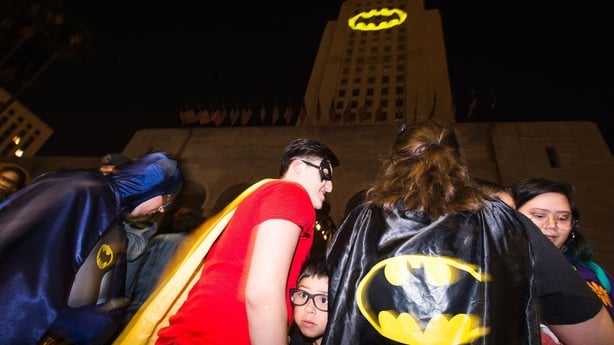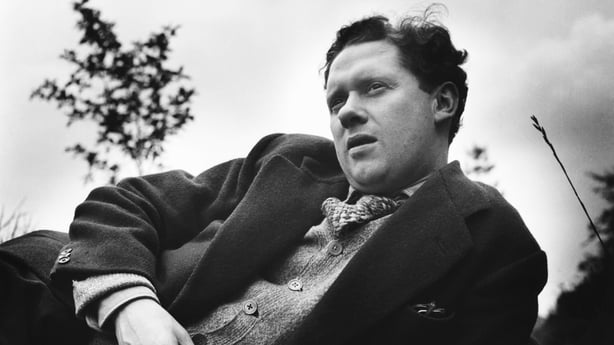If you go looking for details of the content that is about to enter the public domain, you will find a very long list.
Most of it wouldn't be of interest to a general audience - but there are a few very well-known pieces of work that will lose their copyright in the near future.
That includes the songs of Hank Williams - including 'Your Cheatin’ Heart’, 'Hey Good Lookin’’ and his ‘Lovesick Blues’.
The works of Welsh poet Dylan Thomas also enter the public domain next year - including the oft-quoted ‘Do not go gentle into that good night’.
We also have Noddy - the little man with the red and yellow car. Or, more precises, the original illustrations of Noddy – and not the actual Enid Blyton books.
The screenplay for Citizen Kane comes into the public domain too, as does Economic Problems of Socialism in the USSR, by Joseph Stalin.
The stage version of Peter Pan loses its copyright next year too – something that is currently held by Great Ormond Street Hospital, after it was gifted to the organisation by author JM Barrie.
In the US, ‘Lady Chatterley’s Lover’ enters the public domain - so does Virginia Woolf’s ’Orlando’, Agatha Christie’s ‘The Mystery of the Blue Train’, and Bertolt Brecht’s musical ‘The Threepenny Opera’ - which is where the jazz standard ‘Mack The Knife’ originated.
Charlie Chaplin’s ‘The Circus’ is also up - as is the work of his father-in-law, Irish American playwright Eugene O’Neill, who wrote ‘Long Day’s Journey into Night’.
But the big one, really, and the one that so many people are waiting for, are Mickey Mouse and Minnie Mouse.
After a long wait, they enter the public domain from the start of next year.
What does it mean that these are going into the public domain?
First and foremost you can reproduce the original works without having to pay royalties, or any kind of licensing fees, to the original author or their estate.
So you could publish them online, or sell copies of them, and not be at risk of being sued - or having to share your earnings.
A really good example of that is Project Gutenberg, which is an online archive of every public domain piece of literature in the world.
So you can go on there right now and download digital versions of lots of old books, put them on your phone or ereader, or even print them off if you want - at no cost, and it’s all perfectly legal.
And next year, there’ll be a few more pieces of work added to that library.
It should be noted, though, there are separate protections for published versions – even if the core work is free to use.
So, for example, you could publish your own version of James Joyce’s Ulysses – but you cannot directly copy the design and layout of an edition you found on the shelf today.
Aside from republishing without any cost - when content and characters comes out of copyright, it also means you can create new, original work based on them - with far less chance of being sued.
So I can go and make my own Mickey Mouse cartoon…?

Not quite.
Because the copyright that expires at the start of a year generally relates to the original work - and not necessarily versions of it that come later.
Mickey Mouse is a great example - because next month the copyright expires on the very first Mickey Mouse cartoon, ‘Steamboat Willie’.
This is the fairly basic, black and white cartoon featuring Mickey Mouse on a boat. Minnie is in it too - and so is their arch-nemesis, Pete.
But they all look quite different to the versions we’re familiar with nowadays. And their iconic voices don’t feature in this either - they were later creations.
So that means, if you want to make your own out-of-copyright Mickey Mouse film, you’ll have to stick quite close to the look of ‘Steamboat Willie’ in order to avoid the risk of being sued by Disney.
And walking that line can be fairly tricky.
For example, ‘Winnie-The-Pooh’ entered the public domain this year – but the copyright that expired related to the original book by AA Milne, and not the one that we’re probably more familiar with today.
In Milne’s original, he isn’t wearing his red t-shirt - that was added on years later.
His name is also hyphenated in the original work - whereas Disney, which owns the property today, goes without the hyphen.
And the original Winnie-The-Pooh story doesn’t include Tigger - he first appears in ‘The House at Pooh Corner’ two years later.
There’s actually an indie horror film that was released this year, that takes advantage of the AA Milne book being in the public domain.
It’s called ‘Winnie-The-Pooh: Blood and Honey’… they’ve kept the hyphens in his name, and there’s no sign of a red t-shirt.
There’s also no sign of Tigger - though he is set to appear in the sequel due out next year. 2024 just so happens to be the year when the copyright on Tigger expires, too.
But aside from those limitations, there are other ways that companies try to protect their creations, even after copyright has expired.
How?

Well copyright expires - but trademarks, in theory, don’t.
And so many companies are trying to build up their stock of trademarks related to their products and characters as a way of keeping control indefinitely.
DC Comics, for example, recently won a case in Germany relating to its trademark of the Batman logo.
Batman as a character is due to enter the public domain in 2035, and while that means that people will be able to reproduce the original comic at that point - and maybe some kind of derivative works.
But their trademark means DC have a good case against anyone who tries to sell merchandise with at Batman logo, for example.
Given that the name and image of Mickey Mouse are so intrinsically linked with the Disney brand, it’s likely that they would also make a strong case against anyone who tried to benefit from its end-of-copyright too.
But are there not ways that people can work around copyright or trademark rules?
There are fair use exceptions to copyright and trademarks - for example, when you’re doing a review or analysis of a piece of work you can quote from it, or play clips, without being in breach of the rules.
The same goes for the likes of news reports - or if you were studying it an education setting.
There is also an exception for parody or pastiche - but this is a tricky one to get right, because the parody defence is a fairly new one in Irish law, and it’s relatively untested.
There is more of a history of it in the US, but even there it’s not the case that you can just call anything a parody, or say it’s fair use, and be legally bulletproof as a result.
Back in May the estate of Andy Warhol lost a US Supreme Court case relating to a photo of Prince taken by Lynn Goldsmith.
Warhol had used the photo as the basis for a series of his silkscreens for Vanity Fair magazine in 1981 - which Goldsmith only learned of after Prince’s death.
She sued Warhol’s estate and the judges ruled that his work had not been transformative - so it was essentially a copy.
In Ireland, the law says the ‘fair use’ of a work should not "unreasonably prejudice the interests" of the rights-owner… and it’s up for debate exactly what that means.
What if your parody version sullies the brand and impacts on the rights-owner’s earnings?
Or what if they argue that they wanted to make a spoof version of their work, but you getting their first means they’ve missed out on revenue?
But aside from that there’s also the far more practical part of this.
Even if you feel you have a rock solid fair use argument, do you really want to get caught up in a long, drawn-out and extremely expensive court battle with a company like Disney?
Most people decide to avoid running that risk altogether.
How is it decided what’s entering public domain?

The rules in most of Europe are relatively straight forward nowadays - as it’s deemed that a piece of creative work, like a book or song, enters the public domain 70 years after the author’s death.
That’s been the case since the early 1990s.
If there’s more than one author, it’s 70 years after the last surviving creator’s death.
Going back to the list of work coming up in 2024 - the creators behind them; Dylan Thomas, Hank Williams, Eugene O’Neill - and even Joseph Stalin - all died in 1953.
So we’ll be passed the death plus 70 years point with them all next year.
There are exceptions to that 70-plus rule - as it only applies to work that is published during the creator’s lifetime.
If work is published posthumously, those who publish it then have the rights for 25 years, after which it enters the public domain.
So while generally now all of a person’s work becomes available 70 years after they die, there can be cases where the work comes to the public domain decades earlier, or even decades later.
Is it different in the US?

Yes, the copyright rules in the US are a bit of a mess at the minute, because it’s been transitioning to the 70 years after death rule that’s followed in Europe, but not very smoothly.
Back in the 1970s and 80s, US copyright covered work for 50 years after an author’s death.
Walt Disney died in 1966, so that would have meant that Mickey Mouse would have come into the public domain in 2016.
And not just the ‘Steamboat Willie’ version, any version Walt Disney created, including the 1940s ‘Fantasia’ version, that looks more like the one we’d think of today. And it would have covered and any other character he came up with in the years that followed.
But in 1998 there was a ‘Copyright Term Extension Act’ introduced in the US that ushered in the death plus 70 years rule - and it also made an exception around work published before the 1st of January 1978.
For those works, they would effectively have copyright protection for 95 years after *publication*. Irrespective of the author’s life.
So it will be 2048 before we have the death plus 70 years rule kicking in for US works.
And what’s why we have ‘Steamboat Willie’ - a 1928 cartoon - only coming into the public domain now.
That change in the 1990s was spear-headed by Sonny Bono - of Cher and Sonny – who was a Republican congressman in his latter years. As a result, the law was known as the ‘Sonny Bono Copyright Term Extension Act’.
Though it was also mockingly referred to as the ‘Mickey Mouse Protection Act’, given the level of lobbying that the Disney corporation undertook to get the rules changed in order to protect its key property.







